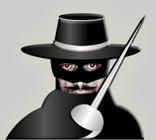Best of Reaktor User Library december 2.015
Blocks
Blikbox v1.1
by Colugo_
A noise/groove box loosely based on laZyfiSh's old Newscool instrument from Reaktor 3.
Thanks to Benjamin Poddig for his ladder filters!
Thanks to Brett Lavallee for contributing the "Scribbles" snapshot bank!
***
Henrietta
by Robert Sigmuntowski
The ensemble emulates the sound and operation of a classical string ensemble chorus effect.
The ensemble operates in mono. As input, the left audio channel (mono) is used;
the output is on the left and right audio channel with the same signal (mono).
***
Karplus-Strong Algorithm Patch
by yerry feldstein
Karplus–Strong string synthesis is a method of physical modelling synthesis
that loops a short waveform through a filtered delay line to simulate the sound
of a hammered or plucked string or some types of percussion.
At first glance, this technique can be viewed as subtractive synthesis based on a feedback loop
similar to that of a comb filter for z-transform analysis.
However, on the other viewpoint, it can also be viewed as the simplest class of wavetable-modification algorithms
now known as digital waveguide synthesis, because the delay line acts to store one period of the signal.
Alexander Strong invented the algorithm, and Kevin Karplus did the first analysis of how it worked.
***
Splatshot
by Colugo_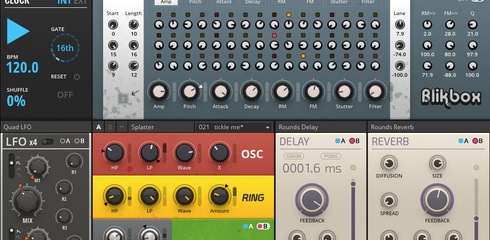
Blikbox + Splatter + some effects. Very easy to quickly create interesting and complex sounding stuff.
***
Effects
Molecular Repeater
by Felix Greenlees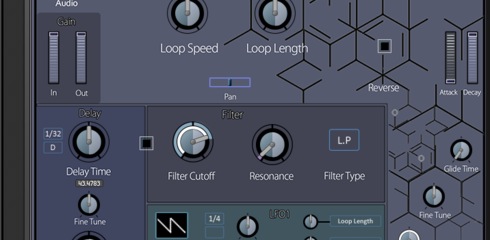
A buffer/Repeater ens based on the Access Virus Atomizer
Made using the Glex Core Cell, this simple Ensemble recreates the Atomizer Section of the Access Virus TI Synthesizer
with an added Filter, Delay and some LFO's.
Example of use:
Put it on an audio channel, and then route a midi channel to the Repeater.
Now pressing a key on the Keyboard will chop up the incoming audio into Sizes determined by the Key Pressed.
At the low end of the Keyboard the slices are Ordered to Sync with the DAW Tempo,
ie C1 = 1 beat, C#1 = 1/2 beat D1=1/4 beat D#1= 1/8 Triplet beat etc.
When the Speed of the repeats hits the audio range, the Pitch of the resulting repeats is set by the Key pressed.
I.e a G3 will repeat the incoming audio at the pitch of G3.
Some time was spent forcing the glex cell to be nice and to play notes 'In Tune', as the usual hz-ms formula's
and even the exact numbers were not working. Thanks to Tristan Boyle for helping me work this out.
Personally I have gotten very used to this method for glitching, repeating stuff both in a live setting and in the studio.
Being able to both repeat something in Sync and then also play the repeated 'notes' as notes or melodies
allows for some truly creative editing and improvising.
The filter and delay both also only function when a Midi input are received(If needed).
These are nothing 2 fancy (Added ZDF filters in reaktor 6 for improved FM)
and the 2 LFO's are just there to make some simple self automating patches
and take it slightly beyond the simple repeater plugin.
In vers 1.42 There is now the option to Sync the Loop length to the LFO
and Visa versa allowing for some creative patches.
Obviously this is no competition to the ultra mega FSU plugs of today,
but I have been using this ensemble for several years, and I have found it very quick to use,
and slightly more focused in its use than many multiFX plugins of its kind.
***
Patina Echo Machine
by Stephen Reid
Primetime Style Tape Echo with Freeze Function
This was my attempt at a mashup between the Soundtoys PrimalTap and Echoboy plugins
(which I own and absolutely love).
I took Michael Hetricks tape style echo and added a freeze/hold function and sample rate multipliers
like you would find in the Prime Time (and thus Primal Tap).
I also added some filtering, distortion, eq etc (special thanks to Boscomac). in the feedback path,
and also delay time modulation to try and emulate old tape echoes and BBD delays (like the echoboy).
This device actually holds up pretty well to my own BBD delay pedals,
and I've tried to emulate the pedals in some of my presets.
The Freeze function and sample rate multipliers are the heart of this ensemble IMO,
and I have spent hours creating evolving loops with this function.
The controls are all relatively self explanatory, and I've tried to write a description for everything.
TIP: View A just shows the basic controls. View B shows everything.
TO DO: There is no tempo sync currently. As I'm just a 'hack it together' guy at the moment
this is a bit beyond my understanding with Reaktor at this time.
***
Sequencers
Euclidean Melodies
by santiago vilanova
Euclidean accented rhythm generator + arpeggiator
Since this first post by Playmodes in the forums:
https://www.native-instruments.com/forum/threads/euclidean.167798/
the Euclidean generator got its own life and evolved into several branches, mods and improvements.
During this time, i've been evolving my own branch for the euclidean rhythm thingie,
adding accents and a sort of arpeggiator.
I just decided to integrate this new features with the Martin Wood-Mitrovski (Normalised)
and Benjamin Kilchhofer branch, which has a nice GUI and looks efficient and usable.
So basically, with this new features, you can fill your sequence with accents
which will be distributed following the "euclidean rule".
You can also define a pitch interval between each step, quantized to a defined scale.
Take a look at the main presets, and play some sequences with your MIDI keyboard.
Instant Philip Glass... have fun!
///////
Version 2.0:
-Accents can have a different duration
-Added Modulo to Pitch section
Version 2.1:
-Added GUI bug fix from Nadine @ NI
-Fixed a bug which caused pitch sequence to start on the second step
***
Polyplex Seq
by Dieter Zobel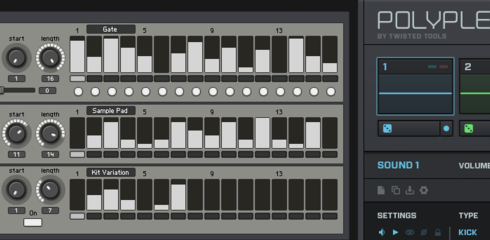
Very simple step sequencer
with MIDI output for driving the Polyplex Drum Sampler
Haben Sie bitte Spass.
didier leboz 2015
for Reaktor 5
***
Vss 2 2.6.6r
by Michael Lancaster
2.6.6r
Refined resets and clock,now much smoother and behaves properly as a plug in and inside Bidule.
Made the +/-CV's block out unipolar.
2.6.5r
I have given vss. block "compatible" outputs for direct connections to blocks
There is no other change
There are 2 ENS.'s one with some blocks and a few snapshots( a basic demo,
I've yet to explore vss and blocks),and the other has the same setup as before.
2.6.4
*** Reaktor 6 ***
Lots of little fixes
and a Manual
***
Synthesizers
Antique
by Brett Lavallee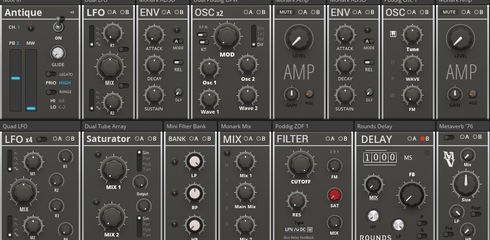
Wandering a lonely flea market on a rainy day, you come across a relaxed old man selling antique audio gear. Among his ancient stereos, broken guitar amps, and moldy smelling microphones, you find a heavy cardboard box with the name "Poddig" written on the side. Inspecting the contents, you see a variety of old testing equipment, which includes filters, oscillators, and other intriguing modules.
Imagining the epic sound design you could do with these devices, you check the price on the box. It is modest, but still out of your reach. Noticing your disappointment, the man speaks. "You like that old stuff? Well, go ahead, take it.. It will be better off with you, than sitting in that box forever." Thanking him, you take the box and rush home, ready to explore the sounds of the past!
•••••••••••••••••••
Version two upgrades the oscillators with Poddig's new design, corrects the FM sources, and adds new snapshots.
***
AutoString V1.2
by gerry feldstein
AutoString V1.2
Press Play
Tip: Stiffness Knob - Filter Cutoff and Resonance and -Time (=Attack) with MIDI Learn ! :)
Want to play itself, unlock all Play switch!
--------------------------------------------------------
SQP
The SQP is a piano roll-style sequencer covering a very wide midi note-range. You can enter notes via the mouse or record incoming MIDI notes. If you want to input longer events with the mouse, just click and drag the start or end of an existing note. Move events by clicking and dragging them around. When [Select] is on you can move selected events as a group.
Velocity:Displays the sequencer's velocity track. Each note in the notes grid has a velocity bar in the velocity track. Drag with the mouse to change the levels.
Select:Toggles select mode on and off. If on, you can select note events by clicking them or by dragging a square around them.
Copy:Copies the currently selected events.
Paste:Pastes the pattern clipboard into the current pattern.
Record:Switches on note recording via MIDI in.
Init:Deletes all note events of the pattern. (Needs to be double clicked!)
Play:Starts and stops the sequencer.
Song Seq:Toggles song mode on and off. If on, the pattern sequence defined under [Song Sequence] is played. If off, the currently selected pattern is played and looped.
ABCD:When not in song mode (see [Song Seq]), the selected pattern is played and looped.
Edit:The edit button enables you to assign patterns to the [Pattern Slots].
A B C D …:When [Song Edit] is active, click into a pattern slot and drag the mouse up or down to select the desired pattern.
Step Seq:Switch off here if you want the old SQP timing system
- Speed / Clock sync -
Controls the input sync (Step Seq only)
Playback mode (Step Seq only)
- Quantize -
Controls the quantization of note events. Choose between quantization in 8th, 16th, 24th and 32th. You can also switch off quantization.
- Zoom -
Choose whether 16, 32, or 64 steps are displayed. This has no influence on the notes played.
- Transpose -
Affects all notes
Press B for this Text.
-----------------------------------------------------------------
CREDITS:
"R66" by Martijn Zwartjes, Martin Jann
SQP by Lazyfish
Interface By Phillip Granzin
SQP+
Mode By Christian Björklund
Playback macros taken from
Midilooper by Mitch Burton
GUI MOD : Yerry Feldstein
***
Electrispace Collection
by Kristian Thom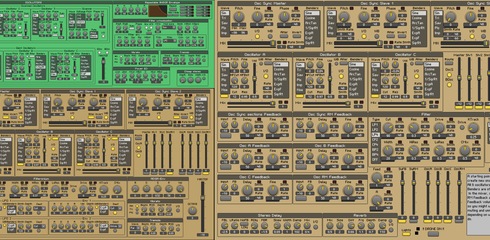
This is a collection of 2 synths, and a 3 voice drone machine thing that can receive MIDI notes.
All the 3 ensembles feature oscillators containing some questionable maths in the form of what I call Benders or Wave Benders (WB). The oscillators can sometimes generate what sounds like electrical sparks, and they are also good for creating sounds that sound like they are coming from a damaged instrument.
While creating snapshots for these ensembles my brain started conjuring up an imaginary space containing three planets called JunQ, AntiQ and Dronedahr ("Drone" is pronounced "Drome" as in "Dromedary"). Dronedahr is mostly a desert planet and the only inhabited one. Planet JunQ and AntiQ are uninhabited and contain the remnants of long dead civilizations. Travelers go there to find sounds, basically. So, when you listen to a snapshot, you are listening to sound that has been found there. When you are creating a snapshot, you are visiting the planet and searching for a sound there. I know it sounds strange (no pun intended), but now I can't think of these instruments without thinking about this imaginary space, so I thought I should mention it and provide some context for the names.
Anyway, JunQ and AntiQ contain no effects like delay or reverb, so all the sounds are dry, and I believe this choice have been influenced by this imaginary space, strangely enough. Dronedahr does contain a delay and a reverb, but this planet is also very different from the other two.
All these ensembles use clippers at the outputs. This is due to the questionable maths I mentioned. It's the sparks/spikes that often cause the unruly levels. Without these clippers your mixer level will often clip, even at low levels. It's difficult to figure out the audio level of these ensembles by looking at the level in your mixer, so I suggest you adjust levels by ear.
Some of the snapshots in AntiQ will sound horrible if you play very high notes, ahem. I think this is mostly caused by Ring Modulation (RM) at high frequencies. If you check out snapshot 30 in AntiQ called "Brokener down", it will sound better if you mute SyncRM in the mixer, and even better if you mute Slv2, but it's not supposed to sound good. It's supposed to sound broken, or even more broken. ;)
Two of the three ensembles (AntiQ and Dronedahr) contain knobs from my recently updated Auto Control Collection, so finally I got around to using these things myself. They are used most frequently in Dronedahr. I have included a PDF with an overview of the Auto Control knob used in AntiQ and Dronedahr. Check out the Auto Control Collection for more info on the Auto Controls.
Dronedahr contains some notes and tips in the B view, but the other two contain a rather limited amout of info, but they shouldn't be too complicated to figure out. There is a long info tip for the Repeatable AHDSR Envelope in JunQ. Some functionality of this envelope is clumsily designed and awkward to use, but I left it in there, since it doesn't affect the normal use of the envelope.
***
reSEMblance
by Maia Dart
I love the Oberheim SEM. This is inspired by the SEM to an extent. I don't know what I'm doing that well, so it's not quite that advanced. It can make some heavy, funky sounds. It also cranks out some nice Sub bass as well as resy/squeaky leads. It sounds pretty great for making 5th or 4th leads too.
It's got 2 main oscillators and an oscillator I like to use as a sub-oscillator (like the SEM has, but a bit more flexible as it doesn't *have* to be sub). I added an LPG on top of an SVF to get some plucky, guitar-esque sounds. I threw in the Rounds delay, because I love Rounds.
***
